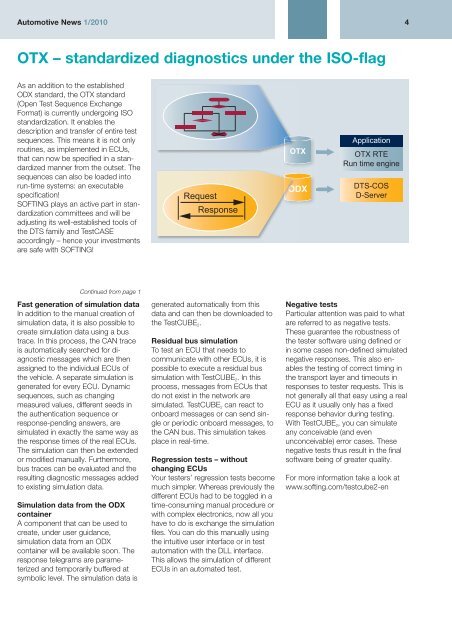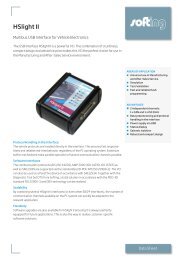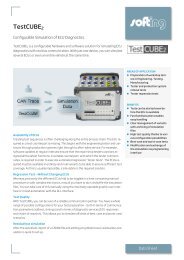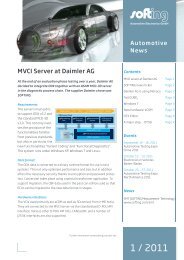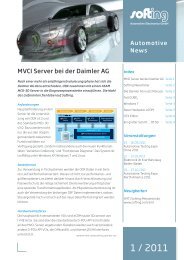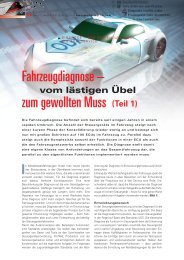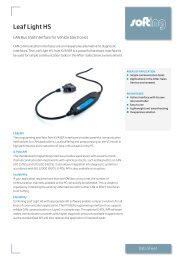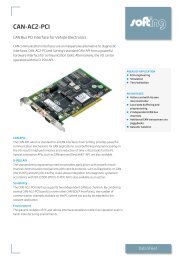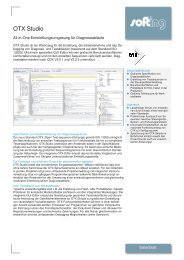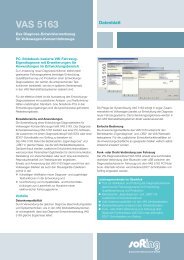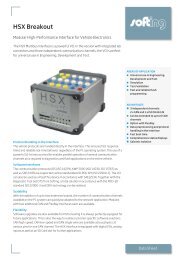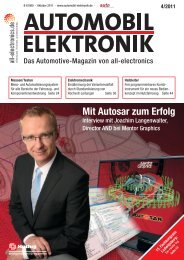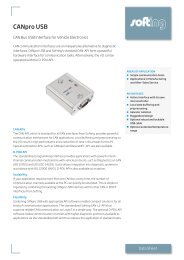Automotive News 1/2010 - Softing Automotive Electronics GmbH
Automotive News 1/2010 - Softing Automotive Electronics GmbH
Automotive News 1/2010 - Softing Automotive Electronics GmbH
You also want an ePaper? Increase the reach of your titles
YUMPU automatically turns print PDFs into web optimized ePapers that Google loves.
<strong>Automotive</strong> <strong>News</strong> 1/<strong>2010</strong> 4<br />
OTX – standardized diagnostics under the ISO-flag<br />
As an addition to the established<br />
ODX standard, the OTX standard<br />
(Open Test Sequence Exchange<br />
Format) is currently undergoing ISO<br />
standardization. It enables the<br />
description and transfer of entire test<br />
sequences. This means it is not only<br />
routines, as implemented in ECUs,<br />
that can now be specified in a standardized<br />
manner from the outset. The<br />
sequences can also be loaded into<br />
run-time systems: an executable<br />
specification!<br />
SOFTING plays an active part in standardization<br />
committees and will be<br />
adjusting its well-established tools of<br />
the DTS family and TestCASE<br />
accordingly – hence your investments<br />
are safe with SOFTING!<br />
Request<br />
Response<br />
OTX<br />
ODX<br />
Application<br />
OTX RTE<br />
Run time engine<br />
DTS-COS<br />
D-Server<br />
Continued from page 1<br />
Fast generation of simulation data<br />
In addition to the manual creation of<br />
simulation data, it is also possible to<br />
create simulation data using a bus<br />
trace. In this process, the CAN trace<br />
is automatically searched for diagnostic<br />
messages which are then<br />
assigned to the individual ECUs of<br />
the vehicle. A separate simulation is<br />
generated for every ECU. Dynamic<br />
sequences, such as changing<br />
measured values, different seeds in<br />
the authentication sequence or<br />
response-pending answers, are<br />
simulated in exactly the same way as<br />
the response times of the real ECUs.<br />
The simulation can then be extended<br />
or modified manually. Furthermore,<br />
bus traces can be evaluated and the<br />
resulting diagnostic messages added<br />
to existing simulation data.<br />
Simulation data from the ODX<br />
container<br />
A component that can be used to<br />
create, under user guidance,<br />
simulation data from an ODX<br />
container will be available soon. The<br />
response telegrams are parameterized<br />
and temporarily buffered at<br />
symbolic level. The simulation data is<br />
generated automatically from this<br />
data and can then be downloaded to<br />
the TestCUBE 2 .<br />
Residual bus simulation<br />
To test an ECU that needs to<br />
communicate with other ECUs, it is<br />
possible to execute a residual bus<br />
simulation with TestCUBE 2 . In this<br />
process, messages from ECUs that<br />
do not exist in the network are<br />
simulated. TestCUBE 2 can react to<br />
onboard messages or can send single<br />
or periodic onboard messages, to<br />
the CAN bus. This simulation takes<br />
place in real-time.<br />
Regression tests – without<br />
changing ECUs<br />
Your testers’ regression tests become<br />
much simpler. Whereas previously the<br />
different ECUs had to be toggled in a<br />
time-consuming manual procedure or<br />
with complex electronics, now all you<br />
have to do is exchange the simulation<br />
files. You can do this manually using<br />
the intuitive user interface or in test<br />
automation with the DLL interface.<br />
This allows the simulation of different<br />
ECUs in an automated test.<br />
Negative tests<br />
Particular attention was paid to what<br />
are referred to as negative tests.<br />
These guarantee the robustness of<br />
the tester software using defined or<br />
in some cases non-defined simulated<br />
negative responses. This also enables<br />
the testing of correct timing in<br />
the transport layer and timeouts in<br />
responses to tester requests. This is<br />
not generally all that easy using a real<br />
ECU as it usually only has a fixed<br />
response behavior during testing.<br />
With TestCUBE 2 , you can simulate<br />
any conceivable (and even<br />
unconceivable) error cases. These<br />
negative tests thus result in the final<br />
software being of greater quality.<br />
For more information take a look at<br />
www.softing.com/testcube2-en


